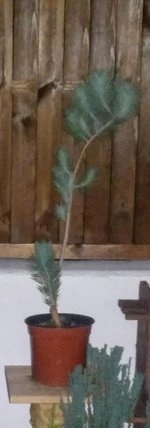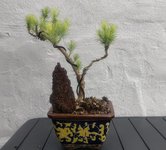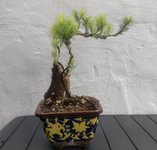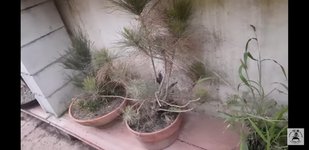As much as I know, this is not a good tree for bonsai. Yes it backbuds, but their 5 adult needles are so, so long, that it seems no one is eager to work on it.
I have heard that you can control it, prunning usually, so you have always juvenile needls like now. And that is what I have been doing.
So I wanted to know your opinion and advices about wich the front of this tree should be, how should I style it, how to keep its needles under control, and any thoughts you have about this project.
Thanks in advance
Needle length in a pine (and foliage size in many many tree species) is ultimately a function of water input, not pruning or pinching practices
per se. The pine in your photo looks like a great candidate for bonsai and if I had this tree I'd be excited to develop it into a bonsai.
You said it yourself: this tree backbuds. That mechanism, along with a constricted root volume, is all you need. Repeated ramification of branches while holding total possible rootage at a fixed volume is your path to increasing the population of buds. As the population of buds increases and begins to draw enough water to match the capacity of either this pot or a future pot (likely a shallower bonsai pot), you should gradually see a change in needle characteristic. If you want to ramify this tree significantly, you'll need to allow it attain vigor/momentum as opposed to continuously cutting it back and inducing juvenile growth.
During early development, long needles can even be thought of as highly desirable to keep momentum high (since foliar surface area serves your development goals: thicken trunk, grow roots, heal wounds, generate more buds).
At Hagedorn's garden, students of pine growing are shown a ponderosa pine that has NOT been grafted with foliage from a different pine species. It's 100% ponderosa from top to bottom, and yet the needles are remarkably short, looking similar to nearby lodgepole and other pines. How is this achieved? Through ramification and management of water. Hagedorn is quick to note that
this is not a suggestion to starve a pine of water. Rather, it's just an observation that long needle length isn't an impassable barrier, it's just an expression of the tree's geometry and water-absorbing surface area at a given stage of development.
If you want a very dramatic demonstration of krumholtzing / water division among shoots in a very short time (esp. in the Canary Islands), I suggest planting a few succulent cuttings into very-well-draining pots of 100% pumice and keeping those pots no more than about 1 cup (230mL) in size. Place them in the absolute sunniest location you have (on your roof if necessary), and fertilize the daylights out of them. Then compare to a control group of cuttings that you've put into much larger containers with more heavily-water-retaining soil and otherwise treated the same way.
















